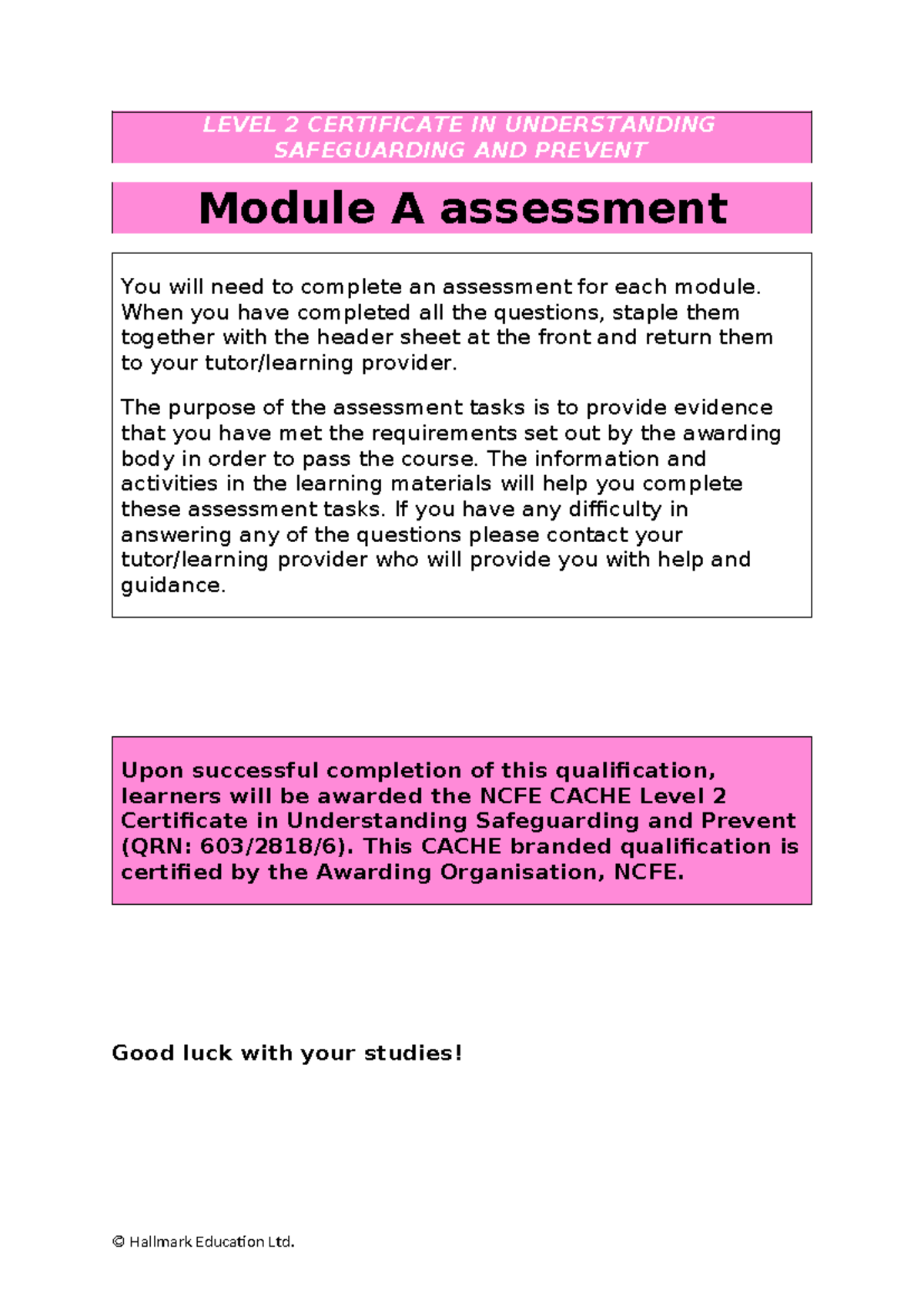
How to Become a Certificate in Understanding Safeguarding: Expert Guide
Are you ready to take your commitment to safety and security to the next level? Earning a Certificate in Understanding Safeguarding and Prevent is more than just a credential; it’s a crucial step towards making a real difference in your community.
This certification empowers you to protect vulnerable individuals and contribute to a safer society. Imagine having the knowledge and skills to identify risks and take action to prevent harm. This article will guide you through the entire process, showing you how to gain this vital expertise and enhance your professional qualifications.
Stay with us to discover how you can play a pivotal role in safeguarding those who need it most.
Importance Of Safeguarding Certification
Understanding safeguarding is crucial in today’s society. It ensures the protection of vulnerable individuals. Certification in safeguarding demonstrates your commitment to this cause. It equips you with the knowledge needed to prevent harm. This certification is vital for anyone working with children and adults at risk. It provides the skills to recognize and address potential dangers. Obtaining this certification is not just a formality. It is a responsibility and a commitment to safety.
Understanding The Role Of Safeguarding Certification
Safeguarding certification is more than a piece of paper. It represents a thorough understanding of safeguarding principles. This certification teaches how to identify risks. It guides on how to act appropriately. Certified individuals can spot early signs of abuse or neglect. They know the steps to take to protect those in danger. This makes a real difference in people’s lives.
Enhancing Trust And Credibility
Certification enhances your credibility in the community. People trust certified professionals to act in their best interest. It shows you have completed thorough training. This gives families peace of mind. They know their loved ones are in safe hands. It reflects a commitment to maintaining high standards of care.
Meeting Legal Requirements
Many sectors require safeguarding certification by law. This includes education, healthcare, and social services. It ensures compliance with legal obligations. Not having this certification can result in legal issues. It’s a crucial part of professional responsibility. Meeting these requirements protects not just individuals, but also organizations.
Improving Personal And Professional Development
Certification is also a step in personal growth. It expands your knowledge and skills. This can lead to career advancement opportunities. Employers value certified staff. They see them as assets to their team. Obtaining this certification shows a dedication to continuous learning. It opens doors to new roles and responsibilities.

Career Opportunities In Safeguarding
Understanding safeguarding and prevent strategies opens diverse career paths. This field ensures the protection and well-being of vulnerable individuals. Professionals in this area play crucial roles across various sectors. From education to healthcare, the demand for safeguarding experts is growing.
Opportunities In Education
Schools need safeguarding officers to protect students from harm. These officers ensure that educational environments are safe. They work closely with teachers and parents. Their goal is to identify and prevent risks early.
Roles In Healthcare
Healthcare settings require safeguarding specialists to protect patients. These professionals ensure patient safety and confidentiality. They collaborate with medical staff to address concerns. Their work is vital in hospitals and clinics.
Positions In Social Work
Social workers often engage in safeguarding practices. They support families and individuals in need. Their role includes identifying potential abuse or neglect. They work to provide safe environments for those at risk.
Opportunities In Law Enforcement
Police officers with safeguarding training handle sensitive cases. They focus on crimes involving vulnerable groups. Their expertise helps in investigations and victim support. This ensures justice and protection for victims.
Roles In Community Services
Community service organizations employ safeguarding advisors. These advisors create safe spaces for community members. They design programs to educate and protect the public. Their efforts help in building safer communities.
Positions In Non-profit Organizations
Non-profits need safeguarding professionals to oversee their operations. They ensure the safety of their clients and volunteers. Their work involves training staff and developing safety policies. This ensures a secure environment for all involved.
Key Skills For Safeguarding Professionals
Safeguarding professionals play a vital role in protecting individuals from harm, abuse, and neglect. To excel in this field, certain key skills are essential. These skills not only enhance your effectiveness but also ensure the safety and well-being of those you aim to protect. Let’s dive into some of these critical skills that can set you apart.
Communication Skills
Clear communication is crucial when dealing with sensitive situations. It involves more than just speaking; listening is equally important. You need to convey information accurately and ensure the person you’re communicating with feels heard.
Consider a situation where you’re helping a vulnerable child. Your ability to explain complex issues simply can make them feel safe. Practicing active listening can help you understand their concerns better. Are you confident in your ability to communicate effectively?
Empathy And Compassion
Empathy allows you to connect with individuals on a deeper level. It helps you understand their emotions and perspectives. Compassion drives you to take actions that prioritize their needs and well-being.
Imagine a time when you felt misunderstood. How did you want others to react? By putting yourself in someone else’s shoes, you can offer support that truly resonates. Your kindness can make a world of difference in someone’s life.
Problem-solving Abilities
Problems in safeguarding are often complex and require thoughtful solutions. Your ability to think critically and creatively is essential in finding effective resolutions.
Picture a challenging scenario where quick thinking is needed to ensure safety. How would you approach it? Being resourceful and adaptable can help you tackle issues efficiently. Are you ready to face unexpected challenges with confidence?
These skills are not just about personal development; they’re about making a meaningful impact. By honing these abilities, you contribute to a safer environment for those who rely on your expertise. What steps will you take to enhance your safeguarding skills today?
Steps To Obtain Safeguarding Certification
Acquiring a certificate in safeguarding is essential for professionals in various fields. It demonstrates a commitment to protecting individuals from harm. These steps guide you through the process to obtain your safeguarding certification. Each step is crucial for your success and understanding.
Choosing The Right Course
Selecting the appropriate safeguarding course is fundamental. Many institutions offer different levels and specializations. Research each option carefully. Consider the course that aligns with your career goals. Look for programs with updated content. Ensure the course covers all necessary safeguarding topics.
Meeting Educational Prerequisites
Before enrolling, verify the educational requirements. Some courses demand previous experience or qualifications. Others may require basic understanding of safeguarding principles. Check the course prerequisites thoroughly. Make sure you meet them to avoid any enrollment issues.
Enrolling In A Certified Program
Once ready, enroll in a certified safeguarding program. Choose a reputable institution for your training. Confirm the program is officially recognized. This ensures your certification holds value. Follow the enrollment instructions provided. Prepare for your studies and engage actively in the learning process.
Course Content And Structure
The journey to becoming certified in Understanding Safeguarding and Prevent is both enriching and structured to ensure you gain vital skills. This course equips you with the knowledge to handle safeguarding issues effectively, which is crucial in today’s world. But what exactly will you learn? Let’s break down the course content and structure to give you a clearer picture of what to expect.
Modules And Topics Covered
The course is divided into several modules, each designed to build on the previous one. You’ll start with the basics of safeguarding, learning about key principles and legal requirements. As you progress, you’ll dive into topics like recognizing signs of abuse and understanding the Prevent duty.
- Introduction to Safeguarding: Understand the fundamentals.
- Legal Frameworks: Learn about the laws that support safeguarding.
- Identifying Abuse: Recognize various forms of abuse and their indicators.
- The Prevent Strategy: Understand how to prevent radicalization.
Each module uses real-world scenarios to make the content relatable. Imagine learning about safeguarding through the lens of a community worker or teacher. How might their experiences shape your understanding?
Assessment And Evaluation Methods
How do you know you’re truly absorbing the material? The course uses a blend of assessment methods to evaluate your progress. You’ll encounter quizzes after each module to test your understanding immediately.
Additionally, you’ll complete a final project that requires you to apply what you’ve learned. This project is a chance to showcase your knowledge by creating a safeguarding plan for a hypothetical organization.
| Assessment Type | Purpose |
|---|---|
| Quizzes | Test knowledge retention after each module. |
| Final Project | Apply learning in a practical scenario. |
Feedback is crucial, so expect detailed comments on your project to guide your learning journey. How do you think this feedback could impact your understanding and future application of safeguarding strategies?
The course’s structure is designed to ensure you’re not just learning, but also applying and reflecting on key safeguarding principles. This approach prepares you to make a real difference in your community and beyond.
Cost And Financial Considerations
Embarking on the journey to earn a Certificate in Understanding Safeguarding and Prevent might have you considering the financial aspects involved. It’s crucial to weigh the costs against the benefits. Understanding tuition fees, scholarships, and grants can help make informed decisions.
Tuition Fees
Tuition fees for this certificate can vary significantly depending on the institution. Some universities offer competitive rates, while others might be more expensive due to additional resources or prestige. It’s wise to compare different options to find one that suits your budget.
Consider checking if there are payment plans available. These can ease the financial burden by spreading the cost over several months. Contacting the admissions office for detailed fee structures can provide further clarity.
Available Scholarships And Grants
Scholarships and grants can significantly reduce your financial burden. Many organizations offer financial assistance to students pursuing safeguarding and prevent studies. Researching these opportunities can open doors to valuable funding.
Look for scholarships provided by the institution itself or external bodies. Some might require essays or proof of financial need, while others may be merit-based. Dedicate time to apply for several grants to increase your chances.
Have you ever thought about how financial support can shape your educational path? Securing a scholarship might be the key to pursuing your passion without financial stress. Take the leap, explore these financial avenues, and see where they lead you.
Maintaining And Renewing Certification
Maintaining and renewing your Certificate in Understanding Safeguarding and Prevent is crucial. It ensures your knowledge stays relevant and up-to-date. This process involves continuous learning and periodic re-certification. Both elements are vital for sustaining your expertise.
Continuing Professional Development
Continuing Professional Development (CPD) helps you grow your skills. It involves regular training sessions and workshops. These activities enhance your safeguarding and prevention knowledge. CPD keeps you informed about new policies and practices. It’s a commitment to lifelong learning. Engaging in CPD activities boosts your competence. It ensures you remain effective in safeguarding roles.
Re-certification Process
Re-certification is necessary to maintain your certification status. It verifies your skills and understanding are up-to-date. This process often involves taking exams or assessments. These evaluate your grasp of current safeguarding standards. Re-certification also involves submitting proof of CPD activities. This demonstrates your ongoing dedication to professional growth. Keeping track of your CPD hours is crucial for this step.
Challenges And Common Mistakes
Embarking on the journey to obtain a Certificate in Understanding Safeguarding and Prevent presents unique challenges. Aspiring professionals often face hurdles that can impede progress. Recognizing common mistakes helps in navigating these obstacles efficiently.
Avoiding Burnout
Burnout is a frequent issue in safeguarding roles. The emotional toll can be overwhelming. Professionals must prioritize self-care to maintain their well-being. Regular breaks and balanced workloads are essential. Connecting with peers can provide support. Sharing experiences fosters resilience. Stress management techniques also help combat burnout.
Staying Updated With Regulations
Regulations in safeguarding are constantly evolving. Staying informed is crucial to compliance. Many professionals struggle with keeping up-to-date. Subscribe to newsletters from trusted organizations. Attend webinars and workshops regularly. Engaging in continuous learning is key. Utilize online platforms that offer regulatory updates. This ensures adherence to current standards.
Benefits Of Being Certified In Safeguarding
Becoming certified in safeguarding brings many advantages. It equips individuals with essential skills to protect vulnerable groups. This certification is crucial in today’s complex environment. It ensures safety and promotes trust within communities. The benefits extend beyond personal development. Certification opens doors to various professional opportunities. It enhances your reputation and career prospects.
Enhanced Credibility
Certification validates your expertise in safeguarding. It proves you have the necessary skills and knowledge. Employers trust certified professionals more. Certification gives you a competitive edge. It shows dedication to safety standards. This boosts your credibility in the field. Being certified sets you apart from others. It strengthens your professional profile. Clients and colleagues recognize your commitment.
Improved Career Prospects
Certified individuals often have better job opportunities. Employers seek professionals who are skilled in safeguarding. Certification opens doors to diverse roles. It increases chances for promotions and raises. Many sectors value safeguarding skills. It is essential in healthcare, education, and social work. Having certification can lead to leadership roles. It positions you for career advancement. Certification is a step towards a fulfilling career.

Frequently Asked Questions
What Is Safeguarding And Prevent Certification?
Safeguarding and Prevent certification educates individuals on protecting vulnerable groups. It covers recognizing signs of abuse and radicalization. This certification is vital for professionals working with children or at-risk adults, ensuring they can act promptly and effectively. It supports creating safer environments in communities and organizations.
How Can I Get Certified In Safeguarding?
To get certified, enroll in a recognized training course. These courses are available online or in-person. They cover essential safeguarding principles and practices. Upon completion, you’ll receive a certificate. Check course prerequisites and ensure the provider is accredited for valid certification.
Why Is Safeguarding Certification Important?
Safeguarding certification is crucial for those working with vulnerable groups. It ensures you understand how to identify and respond to risks. This knowledge helps protect individuals from harm and abuse. Certification also demonstrates your commitment to safety and compliance with legal requirements.
Who Should Take Safeguarding Courses?
Safeguarding courses are essential for educators, healthcare workers, and social workers. Anyone working with vulnerable groups should consider certification. This training helps identify and prevent abuse and radicalization. It equips professionals with the skills to create safe environments.
Conclusion
Embarking on a safeguarding journey builds essential skills. This certification enhances your understanding of vital practices. It empowers you to protect individuals and communities. The course offers practical knowledge for real-world situations. You gain confidence to handle sensitive issues. Education in safeguarding is crucial in today’s world.
It ensures safety and trust in various environments. Taking this step opens doors to new opportunities. You contribute positively to society by becoming informed. Stay committed to learning and improving your skills. With dedication, you can make a real difference.
Start your journey today and be a part of change.




